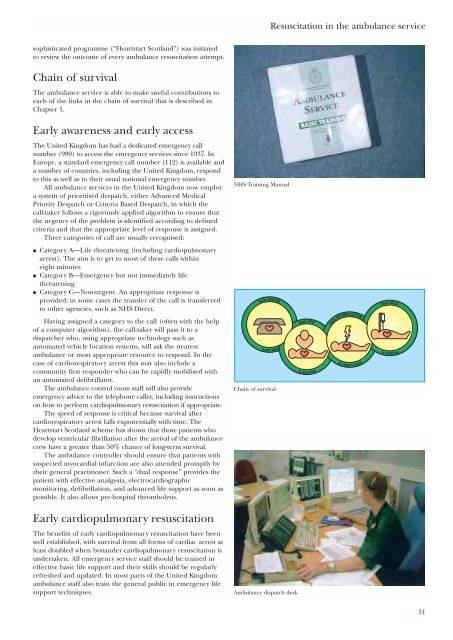RESUSCITATION
RESUSCITATION
RESUSCITATION
Create successful ePaper yourself
Turn your PDF publications into a flip-book with our unique Google optimized e-Paper software.
Resuscitation in the ambulance service<br />
sophisticated programme (“Heartstart Scotland”) was initiated<br />
to review the outcome of every ambulance resuscitation attempt.<br />
Chain of survival<br />
The ambulance service is able to make useful contributions to<br />
each of the links in the chain of survival that is described in<br />
Chapter 1.<br />
Early awareness and early access<br />
The United Kingdom has had a dedicated emergency call<br />
number (999) to access the emergency services since 1937. In<br />
Europe, a standard emergency call number (112) is available and<br />
a number of countries, including the United Kingdom, respond<br />
to this as well as to their usual national emergency number.<br />
All ambulance services in the United Kingdom now employ<br />
a system of prioritised despatch, either Advanced Medical<br />
Priority Despatch or Criteria Based Despatch, in which the<br />
call-taker follows a rigorously applied algorithm to ensure that<br />
the urgency of the problem is identified according to defined<br />
criteria and that the appropriate level of response is assigned.<br />
Three categories of call are usually recognised:<br />
NHS Training Manual<br />
●<br />
●<br />
●<br />
Category A—Life threatening (including cardiopulmonary<br />
arrest). The aim is to get to most of these calls within<br />
eight minutes<br />
Category B—Emergency but not immediately life<br />
threatening<br />
Category C—Non-urgent. An appropriate response is<br />
provided; in some cases the transfer of the call is transferred<br />
to other agencies, such as NHS Direct.<br />
Early ACCESS<br />
Early ACLS<br />
Having assigned a category to the call (often with the help<br />
of a computer algorithm), the call-taker will pass it to a<br />
dispatcher who, using appropriate technology such as<br />
automated vehicle location systems, will ask the nearest<br />
ambulance or most appropriate resource to respond. In the<br />
case of cardiorespiratory arrest this may also include a<br />
community first responder who can be rapidly mobilised with<br />
an automated defibrillator.<br />
The ambulance control room staff will also provide<br />
emergency advice to the telephone caller, including instructions<br />
on how to perform cardiopulmonary resuscitation if appropriate.<br />
The speed of response is critical because survival after<br />
cardiorespiratory arrest falls exponentially with time. The<br />
Heartstart Scotland scheme has shown that those patients who<br />
develop ventricular fibrillation after the arrival of the ambulance<br />
crew have a greater than 50% chance of long-term survival.<br />
The ambulance controller should ensure that patients with<br />
suspected myocardial infarction are also attended promptly by<br />
their general practitioner. Such a “dual response” provides the<br />
patient with effective analgesia, electrocardiographic<br />
monitoring, defibrillation, and advanced life support as soon as<br />
possible. It also allows pre-hospital thrombolysis.<br />
to<br />
get<br />
help<br />
Chain of survival<br />
Early CPR<br />
to<br />
buy<br />
time<br />
Early DEFIBRILLATION<br />
to<br />
restart<br />
heart<br />
to<br />
stabilize<br />
Early cardiopulmonary resuscitation<br />
The benefits of early cardiopulmonary resuscitation have been<br />
well established, with survival from all forms of cardiac arrest at<br />
least doubled when bystander cardiopulmonary resuscitation is<br />
undertaken. All emergency service staff should be trained in<br />
effective basic life support and their skills should be regularly<br />
refreshed and updated. In most parts of the United Kingdom<br />
ambulance staff also train the general public in emergency life<br />
support techniques.<br />
Ambulance dispatch desk<br />
51

















